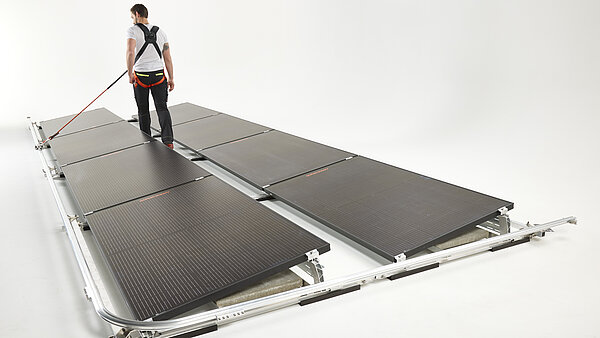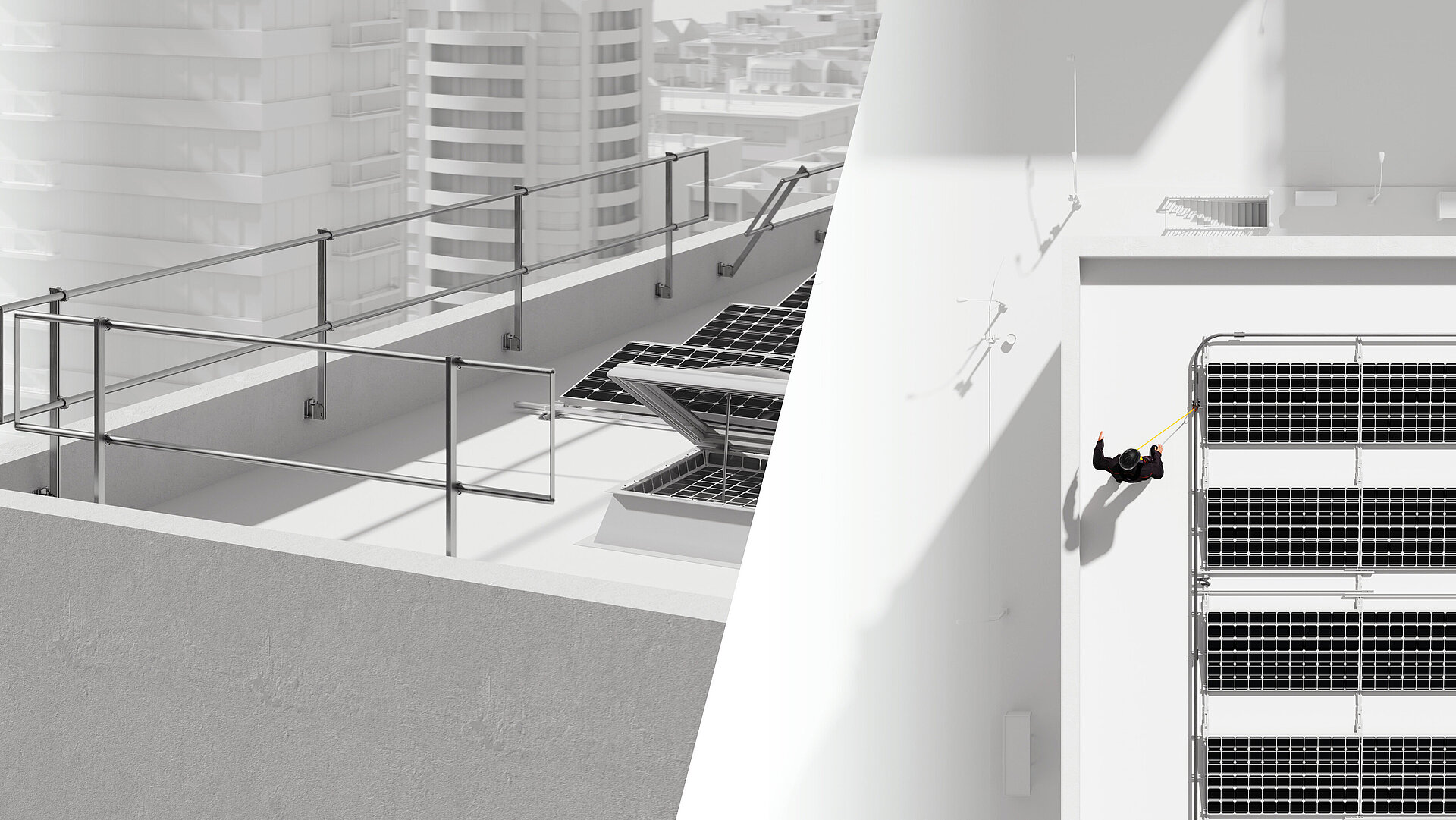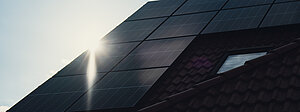Während auf dem Flachdach Gefahren wie etwa Durchbrüche oder ein erhöhtes Absturzrisiko nahe der Dachkanten lauern, ist am Steildach die Neigung selbst die größte Herausforderung. Dazu kommt noch, dass die PV-Anlagen-Betreiber ihre Dachfläche so gut wie möglich für die Solarstromproduktion nutzen möchten, wodurch in der Praxis wenig Platz für eine professionelle und zertifizierte Absturzsicherung bleibt. Diese ist aber nötig, um etwaige Reinigungs- und Wartungsarbeiten sicher durchführen zu können. Außerdem sollte die Sicherungslösung im besten Fall keinerlei Verschattung verursachen, damit die Paneele immer die beste Performance liefern und ein Maximum an Sonnenstrom produzieren können.
Grundsätzlich wird zwischen Kollektiv- und Individualschutz bei der Absturzsicherung von PV-Anlagen auf dem Flachdach unterschieden. Beim Kollektivschutz können gleich mehrere Personen sicher an der PV-Anlage arbeiten, da der Zugang zur Absturzkante effektiv durch ein Geländer versperrt wird. Der Individualschutz dient zur Sicherung gegen Absturz von einzelnen Arbeitern bzw. Reinigungs- und Wartungskräften. In diesem Fall ist der Einsatz einer Persönlichen Schutzausrüstung PSA zwingend vorgeschrieben. Je nach gegebener Situation kann die Wahl also entweder auf eine Kollektiv- oder Individualschutzlösung fallen.
Individualschutzlösungen für Ihre PV-Anlage auf dem Flachdach
Die Seilsicherung AIO, Schienensicherung TAURUS und auch EINZELANSCHLAGPUNKTE sind Beispiele für Individualschutzlösungen. Je nach gegebener Situation können die INNOTECH-Systeme miteinander kombiniert werden. Unter anderem besteht auf dem Flachdach die Möglichkeit die Absturzsicherung direkt auf der Unterkonstruktion der PV-Anlage zu montieren. Diese moderne und bodennahe Befestigung der Sicherungslösung sieht nicht nur optisch sehr gut aus, sondern sorgt dafür, dass es zu keiner Verschattung der Module durch die Absturzsicherung kommt. Eine entsprechende Zertifizierung des Sicherungssystems in Kombination mit der Unterkonstruktion der PV-Anlage ist dahingehend das Um und Auf. Im Folgenden nehmen wir die INNOTECH-Lösungen etwas genauer unter die Lupe.
Die Befestigung der Sicherungssysteme AIO, TAURUS und der EINZELANSCHLAGPUNKTE auf dem Flachdach kann in Bezug auf die Sicherung von PV-Anlagen auf dem Flachdach auf drei Arten erfolgen:
- Durch die Verwendung von z. B. STA-Stützen können die genannten Absturzsicherungen direkt mit der Dachhaut verbunden werden. Kommt es zum Absturz, werden die auftretenden Kräfte in die Dachunterkonstruktion abgeleitet.
- Um Dachhautdurchdringungen zu vermeiden, gibt es die Möglichkeit, auf auflastgehaltene Lösungen in Kombination mit den Sicherungssystemen AIO, TAURUS oder EINZELANSCHLAGPUNKTEN zurückzugreifen(z. B. mit dem Universalpunkt VARIO-45). Hier werden die im Absturz auftretenden Kräfte in die Betongewichte des Universalpunktes abgeleitet.
- Durch die Montage direkt auf der PV-Unterkonstruktion kann die Dachfläche optimal ausgenutzt werden. In diesem Fall dient das Gewicht der PV-Anlage als Auflast/Ballast. Die im Sturz wirkenden Kräfte werden direkt in die PV-Unterkonstruktion abgeleitet. Auch hier entstehen keine Dachdurchdringungen.

Mit dem Laden dieses Videos akzeptieren Sie die Datenschutzbestimmungen von Google.
Es gilt anzumerken, dass sich EINZELANSCHLAGPUNKTE vor allem zur Sicherung von kleinen Dachflächen eignen. Zudem kommen sie vor allem zum Einsatz, wenn Dachecken gegen Pendelsturz gesichert werden müssen oder auch die Sicherung von Zustiegen zu erfolgen hat.
Gilt es einen Weg bis zum Einhängen in ein anderes System zu sichern, so kann auch das problemlos erfolgen und gleichzeitig wird dafür gesorgt, dass eine durchgehende Sicherung am Flachdach gewährleistet ist. Bei Vorhandensein einer großen Flachdachfläche stellt ein Seil- oder Schienensystem die optimale Wahl dar.
Exkurs: PERSÖNLICHE SCHUTZAUSRÜSTUNG PSA
Bei allen oben genannten Individualschutzlösungen ist die Verwendung einer Persönlichen Schutzausrüstung PSA zwingend vorgeschrieben. Je nach Einsatzgebiet stehen unterschiedliche Auffanggurte (PSA-STRING) zur Verfügung. Damit ein sicheres Auffangen eines stürzenden Monteurs oder Arbeiters stattfinden kann, muss eine Verbindung zwischen der Persönlichen Schutzausrüstung und den Anschlagpunkten geschaffen werden. Hierzu bietet INNOTECH ein auf die Systeme abgestimmtes PSA-VERBINDUNGSMITTEL an. Als ideale Ergänzung gibt es passendes PSA-ZUBEHÖR für noch mehr Komfort.
Für Individualschutz-Lösungen spricht:
Je nach Art der Montage der Absturzsicherung entstehen unterschiedliche Benefits in Hinblick auf die Verwendung eines Individualschutzes am Flachdach. Hier unsere Highlights:
- Volle Nutzung der Dachfläche, da die Sicherungslösungen nur wenig Platz benötigen, vor allem bei Befestigung der Absturzsicherung direkt auf der PV-Unterkonstruktion
- Keine Dachhautdurchdringung bei der Verwendung von auflastgehaltenen Individualschutzlösungen oder bei der Befestigung direkt auf der PV-Unterkonstruktion
- Sicherung der gesamten Dachfläche mit nur einem einzigen Sicherungssystem
- Kein Schattenwurf auf die PV-Module aufgrund der bodennahen Montage der Absturzsicherungen bei der Befestigung direkt auf der PV-Unterkonstruktion
Kollektive Sicherungslösungen für die PV-Anlage am Flachdach
Auf einem Flachdach sind nicht nur die Bereiche nahe der Dachkante gefährliche Orte, auch rund um Dachluken oder -fenster/Lichtkuppeln besteht erhöhte Absturzgefahr. Diese Zonen lassen sich grundsätzlich mit einem Kollektivschutz wie einer Geländersicherung (z. B. BARRIER) sehr gut schützen. Mit einer kollektiven Absturzsicherung können sich alle am Dach und somit an der PV-Anlage befindlichen Monteure und Solarteure frei und vor allem sicher bewegen. Oft ist aber das Platzangebot dafür nicht oder kaum vorhanden, oder aber das Dach ist bereits hinsichtliches des Gewichts an die Grenzen der Belastbarkeiten gekommen.
Aber auch diese Absturzsicherungen dürfen die Effizienz der PV-Anlage durch etwaigen Schattenwurf auf die Paneele nicht schmälern. Hier ein Auszug unseres Kollektivschutzes für den Bereich Flachdach:
- BARRIER-VARIO, das Geländersystem mit Gewichten als Auflast
- BARRIER-ATTIKA, das Geländersystem auf Attika montiert
- BARRIER-FLEECE, das Geländersystem mit Gründach als Auflast
- BARRIER LICHTKUPPEL, das Geländersystem um Lichtkuppeln/Lichtbänder
Für die Sicherung von Lichtkuppeln eignen sich Systeme wie die LIGHT-LICHTKUPPELSICHERUNG, das LIGHT-LICHTKUPPELSICHERUNGSNETZ, BARRIER LICHTKUPPEL und auch EAP-MOBI.
Für Kollektivschutz-Lösungen spricht:
Auch die Verwendung eines Kollektivschutzes am Flachdach bringt gewisse Vorteile mit sich. Hier unsere Top 3:
- Gesicherte Fortbewegung auf der ganzen Flachdachfläche sowie entlang der PV-Anlage. Das Tragen einer Persönlichen Schutzausrüstung entfällt.
- Das Dach kann vollwertig genutzt werden.
- Keine Dachhautdurchdringung und somit leichte Nachrüstung möglich.
Mögliche Absturzsicherungen für PV-Anlagen am Steildach
Die Dachneigung an sich stellt am Steildach die größte Herausforderung und zugleich das größte Sicherheitsrisiko dar. Im Gegensatz zum Flachdach können auf dem Steildach nur Individualschutzlösungen eine Sicherung gegen Absturz bieten. Je nach Situation eignen sich unterschiedliche Sicherungslösungen, vor allem das Seilsystem AIO in Kombination mit EAP oder Sicherheitsdachhaken haben sich hier bewährt, um die Arbeiten an der PV-Anlage so sicher wie möglich zu gestalten. Hier ein Auszug von möglichen Systemen:
- AIO-SEILSYSTEM-ÜBERFAHRBAR - ein All-In-One-Seilsystem, wo die Überfahrbarkeit der Seilzwischenhalter und Kurven mit dem jeweiligen Seilgleiter möglich ist
- AIO-SEILSYSTEM-NICHTÜBERFAHRBAR - kann ebenfalls als Rückhalte-, Auffang- und Rettungssystem eingesetzt werden - ein Um- oder Aushängen hat hier zu erfolgen
- EINZELANSCHLAGPUNKT/STÜTZEN-SETARTIKEL - dieses Set beinhaltet sämtliche für die Absturzsicherung notwendige Produkte
- EAP-SLING-11 - der Einzelanschlagpunkt speziell entwickelt für Steildächer
- SICHERHEITSDACHHAKEN - Anschlagpunkt spezielle für Steildächer
- KIT-BOX-SYSTEM - ein vormontiertes All-In-One-Seilsystem
Bei allen hier angeführten Absturzsicherungen ist natürlich auch eine Persönliche Schutzausrichtung (PSA) nötig, um die Monteure bzw. Reinigungs- und Wartungskräfte entsprechend zu sichern. Jetzt mehr zu den Absturzsicherungen für Steil- und Flachdächer finden.
Fazit
Das Arbeiten an PV-Anlagen auf Dächern birgt einige Gefahren in sich. Dazu zählt nicht nur der besondere Gefahrenbereich in der Nähe der Absturzkante, sondern auch Lichtkuppeln oder Lichtbänder, die oft übersehen werden. Daher ist für jeden Einzelfall und je nach Dachtyp zu entscheiden, welche Sicherungslösung – Individual- oder Kollektivschutz – die beste Absturzsicherung darstellt. Eine Individualschutz-Lösung sichert immer nur eine Arbeitskraft auf dem Dach und erfordert zwingend den Einsatz einer professionellen PSA. Der Kollektivschutz benötigt zwar mehr Platz auf dem Dach, schützt aber alle Wartungs- und Reinigungskräfte, die an der PV-Anlage arbeiten. Egal, ob Individual- oder Kollektivschutz, jede Absturzsicherung muss entsprechend zertifiziert und auf dem letzten Stand der Technik sein, um im Ernstfall tatsächlich die Last eines Sturzes auffangen zu können. Denn das Wichtigste ist: 100%ige Sicherheit auf dem Dach!
Kontaktieren Sie uns einfach! Unsere Experten unterstützen Sie sehr gerne dabei, die optimale Absturzsicherung für Ihre PV-Anlage zu finden! Wenn auch Sie die Vorteile einer Zusammenarbeit mit einem professionellen Partner für Absturzsicherungen genießen möchten, laden Sie sich am besten gleich diesen Guide hier herunter.








![[Translate to Englisch:] [Translate to Englisch:]](https://www.innotech-safety.com/fileadmin/_processed_/1/a/csm_Mehrere_PV-Kunden_gleichzeitig_betreuen__kann_oft_zur_Riesenherausforderung_werden-header_c1a520d846.jpg)






















